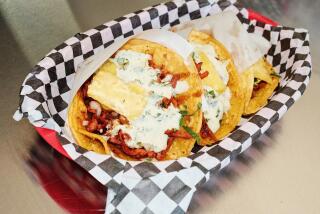Going inside for some ‘truckside’ taco service
- Share via
Most restaurant owners shudder when a food truck pulls up outside.
Not Mike Israyelyan. He invited one inside the Hollywood restaurant he calls Calle Tacos.
Israyelyan and partners Robert Vinokur and Dorian and Javier Villaseñor spent $20,000 to have the side of a 22-foot-long food truck measured and an exact copy fabricated out of stainless steel. Then they equipped it with lights and tires, covered it with a colorful vinyl logo wrap and hauled it on a flatbed to Hollywood Boulevard.
It took 20 people to maneuver the truck replica into the restaurant last year, and they had to take a large glass window out of the Playhouse nightclub next door to get it inside. The truck’s cab door leads to customer restrooms.
These days, the restaurant’s 10 employees dish out burritos, tacos and quesadillas from the mock food truck’s serving windows and occasionally sound a horn that beeps “La Cucaracha” to let customers know their orders are ready.
The dining-room walls outside the truck are decorated with colorful graffiti and spray-painted portraits of old Hollywood stars by local artist Hector Rios. Beneath them is a terrazzo floor that resembles the Walk of Fame.
Israyelyan, who admires his mobile competitors, came up with the idea. “There are some very cool food trucks out there,” said the Studio City resident.
Villaseñor, who manages Calle Tacos with his wife, said he also appreciates food trucks — within limits. “I’m not against the street trucks. But places like this, actual restaurants, have to pay rent, taxes and utilities. And they have a vested interest in the community they’re in,” he said.
Actual food truck operators do a double take when they spy the Calle Tacos truck seemingly parked inside the Hollywood Boulevard storefront.
They’ll pull to a stop in front and snap photos with their cellphones, Villaseñor said. When food truck workers and customers ask him how he got the van inside, he explains that the truck is merely a silhouette.
The gimmick seems to be working: Customers said the eye-catching spectacle of a truck inside a restaurant is what led them to step up to the eatery’s order window.
“It looks real. It stops traffic,” said Mark Rodriguez, 26, a software engineer from East Los Angeles. “I like the way the truck’s door opens and the restrooms are right there.”
Julie Marzouk, 20, a sales clerk from Beverly Hills, said she is convinced the installation is an actual taco truck. “It’s real. It’s just halfway stuck in a wall,” she said, adding: “I’m just glad there’s a place here to sit and eat.”
Friend Hayley Church, 21, a supermarket clerk from Northridge, also couldn’t help comparing the place to a real food truck. Here, she said, “you don’t have to sit on the curb and juggle the food on your knee.”
Drawn inside by the sight of the truck for the first time last week, Santa Barbara college student Paul Carrera, 20, said the restaurant serves as a kind of metaphor for the way food carts and trucks are steppingstones for immigrants and others to become operators of real restaurants.
That’s how 2008 Kogi food truck innovator Roy Choi propelled himself into an actual bricks-and-mortar place on the Westside called Chego. “There is no way we could have gone the traditional route” at first, Choi has acknowledged. Trucks operated by Komodo, Coolhaus and Flying Pig have also opened outlets with actual street addresses.
Still, with some 4,000 licensed food vending vehicles in Los Angeles County, food trucks seem to be everywhere. They won’t be parking in front of Calle Tacos, however: The curb there is painted red.
More to Read
Sign up for Essential California
The most important California stories and recommendations in your inbox every morning.
You may occasionally receive promotional content from the Los Angeles Times.











